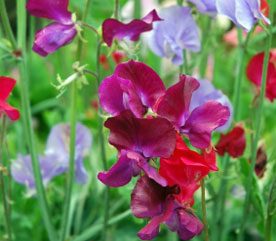Learn About Growing Sweet Peas
The most popular variety of sweet pea, Lathyrus odoratus, lives up well to its name. Odoratus is Latin for ‘well-scented’, and these flowers have been prized by gardeners for their delicious fragrance for centuries.

Since many modern sweet peas have been bred primarily for their colour, the varieties with the best scent are usually the oldest. However, the newer Spencer Type cultivars used in the two arrangements opposite all have fragrant flowers and are available in every shade and colour, except for yellow. The sugar almond shades of pale lavender, soft pink and pure white in the main arrangement make a delicate display, which would work well in a cottage garden setting, surrounded by other pastel blooms.
Sweet pea flowers open in succession, so planting another climber to scramble alongside them will help to ensure that your wigwam blooms throughout the season. To extend the flowering season, morning glory (Ipomoea) makes a perfect companion for sweet peas, as the plants will grow together without one smothering the other. Each morning glory bloom only lasts for one day, but the plant will produce a mass of flowers throughout summer and into early autumn.
In this arrangement the heart-shaped leaves of Ipomoea tricolor ‘Heavenly Blue’ add substance to the finer stems of the sweet peas. As the sweet peas begin to wane, its clear blue trumpet-shaped flowers, with their distinctive white throats, will open.
Sapphires and Rubies
For a more vivid display with stronger colours choose sweet peas in the jewel colours of purples, blues and cerises. The column of flowers in the variation makes a sensual focal point on a bend in a path or at the edge of a patio, where its fragrance can be appreciated as you walk by. The tall arrangement will also fill a gap in a border or balance a group of pots filled with shorter plants.
To complement these darker sweet peas, you could also plant an ipomoea with flowers in a deeper shade than ‘Heavenly Blue’. The red or purple common morning glory (I. purpurea) would make a good companion.
Both morning glory and sweet pea seeds need to be planted in small pots in spring and germinated indoors or under glass. Once the young plants are established they may be transplanted into their final container, but it is best to keep them protected until all danger of frost has passed. By this time they should also have started climbing up their supports, and will be less vulnerable to damage from the wind.



